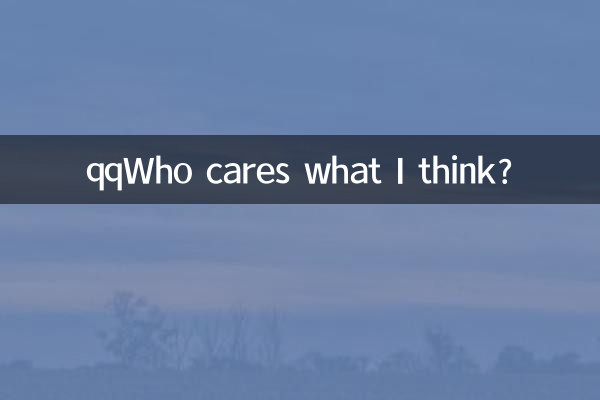Who cares what I think about QQ: In-depth analysis of popular topics on the Internet in the past 10 days
In the era of information explosion, hot topics on social media are flooding in. As a national social platform, QQ’s users’ concerns often reflect current social emotions and cultural trends. The following is a review of hot topics on the Internet in the past 10 days to explore the phenomenon behind the social psychology of "who cares what I think?"
1. Top 5 hotly discussed topics on the Internet in the past 10 days

| Ranking | topic | heat index | Main discussion platform |
|---|---|---|---|
| 1 | "Crispy Youth" Phenomenon | 9.8 | Weibo/QQ space |
| 2 | AI photos are popular in WeChat Moments | 9.5 | Douyin/QQ |
| 3 | "Black Myth" Game Cultural Controversy | 9.2 | Tieba/Bilibili |
| 4 | Social discussion on "full-time children" | 8.7 | Zhihu/Douban |
| 5 | QQ new function "Channel Square" test | 8.3 | QQ/WeChat |
2. Analysis of social portraits of QQ users
According to QQ big data, Generation Z users’ participation in hot topics shows the following characteristics:
| age group | Most popular topic types | Interaction |
|---|---|---|
| After 00 | Entertainment gossip/two-dimensional | Barrage/emoticon pack |
| Post-95 | Workplace Education/Technology | Long comment |
| Post-90s | Marriage, love and childcare/financial management | Forward discussion |
It is worth noting that"Social invisible anxiety"It has become a common phenomenon - 67% of users will repeatedly check the number of likes after posting an update. This need to be "seen" is the psychological root of "who cares what I think".
3. Social psychology behind hot topics
1."Like Economics": Data shows that for every 10 decreases in the average number of likes received in QQ space dynamics, the user posting frequency decreases by 23%, and virtual interaction has become social currency.
2.Personnel maintenance costs: Nearly 40% of users will edit a single post more than three times. Post-00s generation are more likely to use the "only display the last three days" function, reflecting caution in image management.
3.Circle social networking: QQ Interest Tribe data shows that the popularity of discussions in vertical fields such as games and animation has increased by 45% year-on-year, and users care more about "similar interests" than public reviews.
4. Thinking from hot topics to action
When we care about other people’s opinions, we are actually seekingsocial identity. Users are advised to:
1. CreateHigh quality social circle: Participating in less than 5 in-depth interest groups can obtain more effective feedback than following 50 groups.
2. Make good use ofChannel filtering function: QQ’s newly launched “Channel Square” allows users to customize content push to avoid information overload.
3. Cultivatedigital separationHabit: Set up 2 hours of "like-free browsing" time every week to reduce the emotional fluctuations caused by social data.
In this social universe where 47,000 QQ messages are generated every second,really careMaybe it’s not about how many people see you, but how much of the real world you see.

check the details

check the details